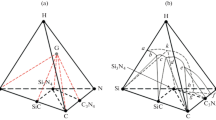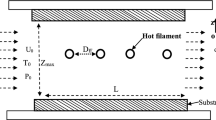Abstract
This work is devoted to the atomistic simulation of chemical vapor deposition (CVD) of thin silicon nitride films from the mixture of dichlorosilane (DCS) and ammonia in CVD reactors. The earlier developed chemical mechanism is substantially extended by including the reactions of catalytic decomposition of DCS, and a self-consistent atomistic model of a CVD process is developed. An extended chemical mechanism is constructed and analyzed that allows one to adequately describe kinetic processes in a gas phase within the ranges of temperature, pressure, and the DCS: NH3 ratio of original reactants, that are characteristic of silicon nitride deposition. An effective kinetic model is developed that involves the calculation of the rate constants and the concentrations of the gas mixture components. A thermodynamic analysis of the surface coverage by various chemisorbed groups is carried out, and equilibrium surface concentrations are obtained for the main chemisorbed groups. Practically significant conclusions are made about the character of the deposition process and, in particular, about the role of the extended chemical mechanism.
Similar content being viewed by others
References
Makhviladze, T.M. and Martjushenko, A.V., About Possibility of a Gas Preheating Usage in LPCVD of Silicon, in Modeling and Simulation of Submicron Technology and Devices. II, Makhviladze, T.M., Ed., Moscow: Nauka-Fizmatlit, 1997, pp. 74–82.
Makhviladze, T.M., Martjushenko, A.V., and Vladimirov, A.S., Low Dimensional Models Development for RTP and RTCVD Reactors, in Modeling and Simulation of Submicron Technology and Devices. II, Makhviladze, T.M., Ed., Moscow: Nauka-Fizmatlit, 1997, pp. 59–73.
Erofeev, A.F., Makhviladze, T.M., Orlowski, M., et al., Comprehensive Model of Rapid Thermal Processing and LPCVD of Silicon, in Modeling and Simulation of Submicron Technology and Devices, Makhviladze, T.M., Ed., Moscow: Inst. Phys. Technol., 1996, pp. 23–40.
Novoselov, K.P., Theoretical Study of Chemical Deposition of Silicon Nitride from the Mixture of Dichlorosilane and Ammonia, in Matematicheskoe modelirovanie submikronnykh tekhnologii i priborov. III (Mathematical Modeling of Submicron Technology and Devices. III), Makhviladze, T.M., Ed., Moscow: Nauka, 2001, pp. 54–81.
Bagatur’yants, A.A., Minushev, A.Kh., Novoselov, K.P., et al., Teoreticheskoe izuchenie mekhanizma i kinetiki gazofaznykh reaktsii v smesi dikhlorosilana i ammiak (Theoretical Study of the Mechanism and Kinetics of Gas-Phase Reactions in a Mixture of Dichlorosilane and Ammonia), Moscow: MAKS Press, 2000.
Bagatur’yants, A.A., Novoselov, K.P., Safonov, A.A., et al., Silicon Nitride Chemical Vapor Deposition Dichlorosilane and Ammonia: Theoretical Study of Surface Structures and Reaction Mechanism, Surf. Sci., 2001, vol. 486, pp. 213–225.
Valiev, K.A., Makhviladze, T.M., and Novoselov, K.P., Atomistic Simulation of Deposition Processes, in Kvantovye komp’yutery, mikro- i nanoelektronika (Quantum Computers and Micro- and Nanoelectronics), Orlikovskii, A.A., Ed., Moscow: Nauka, 2005, pp. 256–276.
Rodgers, S.T. and Jensen, K.F., Multiscale Modeling of Chemical Vapor Deposition, J. Appl. Phys., 1998, vol. 83, pp. 524–530.
Bagatur’yants, A.A., Minushev, A.Kh., Novoselov, K.P., Umanski, S.Ya., et al., Atomistic Simulation of Si3N4 CVD from Dichlorosilane and NH3, in Predictive Simulation of Semiconductor Processing: Status and Challenges, Dabrowski, J. and Weber, E.R., Eds., Springer-Verlag, 2004, pp. 295–356.
Friesner, R.A., Ab initio Quantum Chemistry: Methodology and Applications, Proc. Nat. Acad. Sci. USA, 2005, vol. 102, pp. 6648–6653.
Makhviladze, T. and Sarychev, M., New Results of Modeling in Micro- and Nanoelectronics, Int. Conf. Micro- and Nanoelectronics: Book of Abstracts, (Moscow, 2007), Moscow: Fiz.-Tekhnol. Inst., Ross. Akad. Nauk, 2007, pp. L1–L6.
Makhviladze, T. and Minushev, A.Kh., Advanced Atomic-Scale Simulation of Silicon Nitride from Dichlorosilane and Ammonia, Proc. SPIE, 2010, vol. 7521, p. 75211A.
Roenigk, K.F. and Jensen, K.F., Low Pressure CVD of Silicon Nitride, J. Electrochem. Soc., 1987, vol. 134, pp. 1777–1785.
Peev, G., Zambov, L., and Yanakiev, Y., Kinetics of the Chemical Reaction between Dichlorosilane and Ammonia during Silicon Nitride Film Deposition, Thin Solid Films, 1990, vol. 189, pp. 275–282.
Sorita, T., Satake, T., Adachi, H., Ogata, T., and Kobayashi, K., Mass Spectrometric and Kinetic Study of Low-Pressure Chemical Vapor Deposition of Si3N4 Thin Films from SiH2Cl2 and NH3, J. Electrochem. Soc., 1994, vol. 141, pp. 3505–3511.
Kusakabe, Y., Hanaoka, K., Komori, H., Ohnishi, H., and Yamanishi, K., Investigation of Precursors Formed by Mixing SiH2Cl2 with NH3 for Chemical Vapor Deposition of Silicon Nitride Films, Jpn. J. Appl. Phys., 1997, vol. 36, pp. 6–10.
Gordon, M.S. and Schmidt, M.W., Advances in Electronic Structure Theory: GAMESS a Decade Later, in Theory and Applications of Computational Chemistry: The First Forty Years, Dykstra, C.E., Frenking, G., Kim, K.S., and Scuseria, G.E., Eds., Amsterdam: Elsevier, 2005, pp. 1167–1189.
Frisch, M.J., Trucks, G.W., Schlegel, H.B., et al., Gaussian 03, Revision C.02, Gaussian, Inc. Wallingford, CT, 2004.
Eyring, H., Lin, S.H., and Lin, S.M., Basic Chemical Kinetics, New York: Wiley, 1980.
Gilbert, R.G. and Smith, S.C., Theory of Unimolecular and Recombination Reactions, Oxford: Blackwell Sci., 1990.
Makhviladze, T.M. and Sarychev, M.E., Thermodynamic Analysis of the Strength of the Boundary of Joined Materials as Function of Their Microstructure and the Concentration of Point Defects, Fiz.-Tekhnol. Inst., Ross. Akad. Nauk, 2009, vol. 20, pp. 111–134.
Goldstein, R., Makhviladze, T., and Sarychev, M., The Thermodynamic Theory of Interfacial Adhesion between Materials Containing Point Defects, Proc. SPIE—Int. Soc. Opt. Eng., 2010, vol. 7521, p. 75211B.
Gol’dshtein, R.V., Makhviladze, T.M., and Sarychev, M.E., The Effect of Impurities on the Adhesive Detachment Energy along the Interface of Joined Materials, Poverkhnost, 2009, no. 12, pp. 73–78.
Alekseev, I.M., Makhviladze, T.M., Minushev, A.Kh., and Sarychev, M.E., Simulation of the Effect of Impurities on the Adhesive Detachment Energy along the Interface of Joined Solid-State Materials, Fiz.-Tekhnol. Inst., Ross. Akad. Nauk, 2011, vol. 21, pp. 85–94.
Alekseev, T., Makhviladze, A., and Minushev, M., Sarychev. Modeling of the Interfacial Separation Work in the Dependence on the Impurity Concentrations in Adjoining Materials, Proc. SPIE, 2010, vol. 7521, p. 75211C.
Author information
Authors and Affiliations
Corresponding author
Additional information
Original Russian Text © T.M. Makhviladze, A.Kh. Minushev, M.E. Sarychev, 2012, published in Mikroelektronika, 2012, Vol. 41, No. 3, pp. 215–224.
Rights and permissions
About this article
Cite this article
Makhviladze, T.M., Minushev, A.K. & Sarychev, M.E. Nonempirical simulation of chemical deposition of silicon nitride films in CVD reactors. Russ Microelectron 41, 196–205 (2012). https://doi.org/10.1134/S1063739712030055
Received:
Published:
Issue Date:
DOI: https://doi.org/10.1134/S1063739712030055




